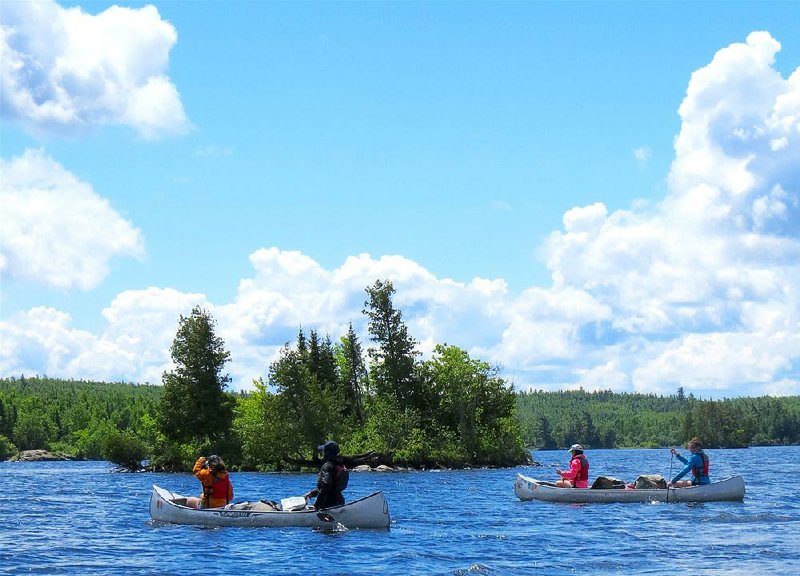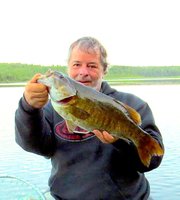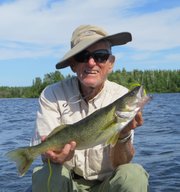ELY, Minn. — Imagine a water world, mainly accessible only to canoes, where gamefish are plentiful and big.
Big means 3-pound crappie, pie plate bluegills and smallmouth bass that run upward of 5 pounds.
I spent the last week of June in such a world, in the Boundary Waters Canoe Area Wilderness of northern Minnesota.
Water defines the Boundary Waters Canoe Area Wilderness, which is known locally as the BWCA. It shelters more than 1,000 lakes and about 1,500 miles of designated canoe routes.
On the big lakes, canoes are as numerous as powerboats on Lake Hamilton. They are mostly long, tan We-No-Nah canoes made of Kevlar. They are light enough for one person to carry, and they haul a lot of gear.
This trip originated about this time last year when Copley Smoak of Pearcy, a longtime reader of this section, emailed a photo of a big smallmouth bass he caught on a fly in the BWCA.
Smoak, 83, has sojourned in the BWCA for nearly 40 years, but he lamented that the 2016 trip was probably his last. His companions had either died or were no longer physically able to endure the journey.
In my reply to Smoak, I mentioned that visiting the BWCA was a lifelong desire.
Next thing I knew, Smoak had secured a permit for 2017. Participation was mandatory. My son Matthew and daughter Amy hinted strongly that they wanted to be invited, and they were.
“Our entry date is June 24,” Smoak wrote. “The permit is good for 14 days, but five days is usually enough for most folks.”
Smoak is an eclectic man. He worked 30 years for IBM, but he’s spent many of his retired years collecting data on Mayan cichlids for The Conservancy of Southwest Florida.
He also designed and builds his proprietary Omni Rods. It is long and limber like a fly rod, but its dual seats enable it to be used with a fly reel or spinning reel. Smoak was denied a patent, he said, because a dual-seat rod was made in 1912, before spinning reels were invented.
Upon arrival in Ely, we stopped at Piragis Northwoods Company, where I engaged a customer about smallmouth bass fishing.
We are often told that folks in the Northwoods consider smallmouth bass to be trash fish. That’s a myth. They esteem their smallmouths as much as we do, if not more.
Even though giant smallmouths inhabit the BWCA, my acquaintance said, most anglers use small baits and ultralight tackle to catch them.
“Topwaters work really well,” the man said, “but you have to be very subtle.”
Meaning?
“When the bait hits the water, don’t move it for a good, long while,” he said. “Wait for the ripples to die away. Tell yourself a joke. Take a couple of long swigs of coffee or whatever, but don’t move the lure. One second it will be there, and the next second it won’t.
“If you twitch it and jerk it, you won’t get a bite,” he added. “That’s my tip. Good luck!”
That’s how Smoak fishes. He casts a yellow popping bug early in the morning and late in the evening when there’s no wind and the water is dead calm. The bug mimics a yellow drake, a big fly that is abundant this time of year.
“I cast it to the edge of the grass and let it soak,” Smoak said. “They give it a good workout, but the Omni Rod always whips their ass.”
We didn’t have much calm water during our six days at Basswood Lake. Smoak’s canoes — 17-foot, square-stern Esquif Herons powered by 3-hp Nissan outboards — were packed with provisions and gear. That made the 15-mile journey from Moose Lake and back very rough and wet through 20-mph headwinds.
We made camp during a lull in the rain. Amy’s Hennessey hammock kept her off the ground, and its batwing-shaped fly was utterly rainproof. Matt and I pitched our tents side by side in a small opening downhill from Amy. Smoak camped in a tiny opening up the hill, but his leaky North Face tent made his nights unpleasant.
After pitching camp, Smoak and I took a canoe out to fish a vast expanse of submerged grass that he calls “The Biomass.” The water is only 10-12 feet deep at most, but the grass comes almost to the surface, and it harbors an impressive diversity of fish.
We used light jigs tipped with Charlie Brewer Sliders, tiny plastic grubs that we use for bream and crappie fishing in Arkansas. We cast upwind and dragged them across the grasstops.
I caught a lot of northern pike and yellow perch, both firsts for me, but Smoak caught two of the biggest crappie I’ve ever seen, as well as a massive bluegill. He also caught a 16-inch smallmouth bass and a little largemouth bass.
The water was very clear, but tea colored. Because of this, all of the fish, except for northern pike and yellow perch, were very dark, almost black.
The wind finally died the next evening. Amy and I cast topwaters on the lee side of the island. I used a bone colored Zara Puppy as my tipster advised.
Northwoods smallmouths don’t blow up on a topwater the way southern smallies do. They roll on it. I missed the first two strikes, but I finally connected on the third. It was a subtle, sipping strike of little apparent consequence, but when I loaded the rod, I lost my breath. The fish displaced much water with a deep, resonant splash that suggested immensity. My rod arced deeply, and when I saw the fish up close, my summer was complete.
“This is the biggest smallmouth I’ve ever seen!” I gasped.
It was 21 inches long, about 5 pounds, with a deep hue of burnished bronze. If I didn’t catch another fish, I would be happy, but there was more to come. Much more.
The next day was bright, sunny and windy. I talked Smoak into trolling crankbaits, a technique that is foreign to him. I caught a couple of northern pike on the leeward side of a point with a Rapala Jointed Shad Rap in Tennessee Shad color, so I suggested trolling over the deep end of the point in the wind.
My first fish was a 19-inch smallmouth that glowed in the sun. The next was a 3½-pound walleye that fed our group.
The next morning, fishing alone, I caught two more smallmouths on a clear Heddon Baby Torpedo. One was 16 inches long. The other was a tad smaller than my 5-pounder.
“They have 6- and 7-pounders out here,” Smoak said, “but a fish like that is pretty much at the upper end of what people catch.”
Smoak caught one, too, a 4-pounder while fishing with Matthew, on the one calm morning that allowed him to soak a fly.
My daydreams have been stale lately, but those fish revitalized them.



